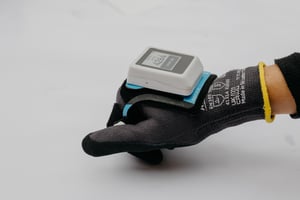NIMMSTA is at the center of an impressive transformation in the logistics sector that has led the...
Wearables: the key to efficiency in Industry 4.0
Digital transformation is becoming increasingly important in modern industry, and wearables are a key technology that is gaining in importance. Wearables such as back-of-hand scanners and smart devices worn directly on the body enable seamless communication, speed up work processes and improve precision in workflows. In intralogistics in particular, wearables are changing the way employees interact with systems and how processes are optimized.
Why wearables are so important in industry
 Wearables are portable technologies that provide information directly on the user's body. This can be done via devices such as industrial smart watches, AR glasses or back-of-hand scanners. In intralogistics, wearables facilitate direct interaction with digital systems by providing data in real time and thus minimizing time lost due to access to stationary computers or handheld devices.
Wearables are portable technologies that provide information directly on the user's body. This can be done via devices such as industrial smart watches, AR glasses or back-of-hand scanners. In intralogistics, wearables facilitate direct interaction with digital systems by providing data in real time and thus minimizing time lost due to access to stationary computers or handheld devices.
One of the most significant advantages is the ability to optimize processes and reduce errors through wearables. Industrial smart watches, for example, enable fast and accurate data entry and recording. Employees can read data directly from the back of their hand and enter it into the system without having to leave their workstation, which not only increases efficiency but also makes operation more intuitive and ergonomic.
Market development for wearables in industry
The market for wearables in industry is growing steadily. According to forecasts, the global market for industrial wearables will increase to around 13.8 billion US dollars by 2028, with an annual growth rate of 11.8%.* This enormous demand is the result of the growing need for automation and wireless technologies in industry. Companies that adopt these technologies early on can achieve long-term benefits and secure their competitiveness in Industry 4.0. Wearables such as AR glasses and smart watches are particularly popular in the logistics and manufacturing sectors, where real-time data and precise communication are essential.
Advantages of wearables in logistics
The use of wearables in logistics brings many benefits that affect both employees and the processes themselves:
-
Real-time data access: employees have direct access to all important information and data without the need for additional devices. This means that information is available exactly where it is needed.
-
Optimized processes and error reduction: As wearables make it possible to process data faster and more precisely, errors are reduced and processing efficiency increases.
-
Greater safety and convenience: The devices are often ergonomically designed and can be operated intuitively. This increases safety and comfort for employees and reduces physical strain.
Areas of application for wearables in industry
Wearables are not only used in logistics, but also in numerous other industrial sectors. The smart watch is particularly versatile and can be used wherever input and confirmations are required. Thanks to its touch display, it enables bidirectional communication: the system sends information to the employees, who can respond and make entries directly via the smart watch. This creates a continuous exchange between people and the system, which increases efficiency and reduces sources of error.
In contrast, back-of-hand scanners and AR glasses often only offer one-way communication. For example, back-of-hand scanners can be used primarily for mobile data capture, while AR glasses mainly provide information for viewing. These technologies are valuable when it comes to quickly capturing data or displaying instructions, but often lack the direct interaction capability that smartwatches offer.
The specific functions and application areas of wearables allow companies to select the optimal solution for their work processes and improve the productivity and safety of their employees in a targeted manner.
The future of wearables in industry
Wearables in industry have the potential to fundamentally change the way we work. As the market continues to grow and new technologies are developed, wearables are increasingly becoming an indispensable part of Industry 4.0. Wearables are accelerating digital transformation by making workflows more efficient while increasing flexibility and safety in the workplace.
For companies of all sizes, from SMEs to large corporations, wearables offer an opportunity to optimize their processes and prepare for the future. By investing in these technologies now, you are betting on a way of working that is not only more efficient, but also safer and more intuitive. The development of the market clearly shows that the integration of wearables into industrial processes will play a decisive role in the future of logistics and manufacturing.
*Source: Industrial Wearable Market: Trends, Opportunities and Competitive Analysis 2023-2028




